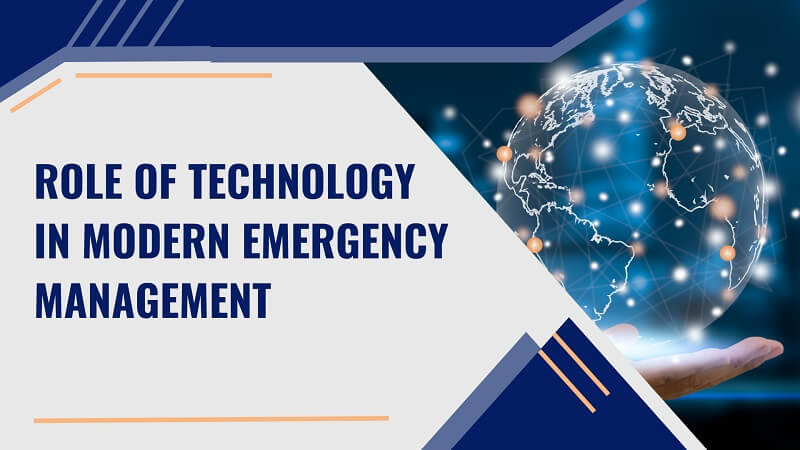
The Role of Technology in Modern Emergency Management
The field of emergency management has seen a profound transformation over the years, largely driven by technological advancements. Today, technology plays a central role in enhancing our ability to prepare for, respond to, and recover from emergencies, especially through the use of emergency management software. This article explores the critical role of technology in modern emergency management, highlighting how it empowers responders and strengthens community resilience in the face of a wide range of crises.
Role of Technology in Modern Emergency Management:
1. Early Warning Systems: Anticipating the Unpredictable
Early warning systems are the front line of disaster preparedness. Technology has revolutionized these systems by providing real-time data collection and analysis, enabling faster and more accurate predictions of natural disasters. From seismic sensors that detect impending earthquakes to meteorological satellites that track hurricanes, technology allows us to anticipate crises like never before. Timely warnings save lives by giving people and communities the precious minutes they need to evacuate or take protective actions.
2. Remote Sensing and GIS Mapping: Precision in Crisis Response
Geographic Information Systems (GIS) and remote sensing technologies have revolutionized emergency management. They offer precise mapping of disaster-affected areas, helping responders identify critical hotspots, allocate resources efficiently, and plan evacuation routes. Drones equipped with cameras and sensors provide aerial views of disaster scenes, aiding search and rescue operations, damage assessments, and environmental monitoring. These technologies ensure that aid reaches the right places at the right time, minimizing the impact of disasters.
3. Communication and Coordination: Breaking Down Barriers
Communication is the backbone of effective emergency management. Modern technology has bridged communication gaps by providing resilient and interoperable systems. First responders use dedicated radio networks and satellite communication to stay connected, even in areas with damaged infrastructure. Moreover, social media and mobile apps empower individuals to share real-time information and request assistance during emergencies. Digital platforms, such as emergency management solutions, facilitate collaboration between agencies, enabling seamless coordination of resources and personnel.
4. Big Data and Predictive Analytics: Enhancing Preparedness
Big data and predictive analytics harness the power of vast datasets to improve Preparedness. These technologies analyze historical data, weather patterns, population demographics, and social media trends to anticipate potential risks. By identifying vulnerabilities and potential impact areas, emergency managers can develop more targeted strategies for disaster prevention and response. For instance, predicting disease outbreaks or identifying flood-prone regions allows authorities to deploy resources proactively.
5. Artificial Intelligence and Machine Learning: Rapid Decision-Making
Artificial intelligence (AI) and machine learning algorithms empower emergency managers with tools to make informed decisions quickly. AI can process vast amounts of data from multiple sources, such as weather forecasts, traffic patterns, and social media updates, to generate real-time insights. These insights aid in resource allocation, incident prediction, and risk assessment. Machine learning models can also identify patterns in data, helping emergency management teams fine-tune their strategies for better outcomes.
6. Mobile Apps and Emergency Alerts: Empowering the Public
Mobile applications have become indispensable tools for public safety. Governments and organizations develop emergency alert apps to deliver critical information directly to people’s smartphones. These apps provide instant notifications about severe weather, Amber Alerts, and other imminent threats. Additionally, they often include interactive features like maps, shelter locations, and emergency contact information, allowing individuals to make informed decisions and take appropriate actions during emergencies. No code app builders like Fliplet can help to deliver mobile apps for emergency management.
7. Robotics and Automation: Enhancing Response Efficiency
Robots and automation are increasingly used in emergency response operations. Robots can navigate hazardous environments, search for survivors in rubble, and perform dangerous tasks, reducing the risk to human responders. Drones equipped with thermal cameras are employed for nighttime search and rescue missions. As technology continues to advance, these robotic systems are becoming more capable and versatile, further improving emergency response capabilities.
8. Cybersecurity: Protecting Critical Infrastructure
In the digital age, cybersecurity is an integral part of emergency management. Ensuring the security of critical infrastructure, such as power grids and communication networks, is essential to preventing and mitigating emergencies. Technology plays a dual role by both safeguarding these systems from cyberattacks and enabling rapid response in case of a breach. Cybersecurity experts work alongside emergency management teams to maintain the integrity and functionality of vital infrastructure during crises.
Conclusion: Harnessing Innovation for Safer Communities
Technology has evolved into an indispensable ally in modern emergency management. From early warning systems that predict natural disasters to AI-driven decision support tools that aid responders, innovation continues to shape the way we prepare for and respond to crises. By harnessing the potential of technology, emergency managers, responders, and communities can collaborate effectively, minimize risks, and build resilience in the face of an ever-changing world. As technology continues to advance, the role it plays in safeguarding lives and property will only become more crucial.
Interesting Related Article: Tips for Crafting an Effective Startup Brand Strategy.